
H-Alpha Sun – May 4, 2010
By Stephen Ames
I use:
Crayola Cerulean pencil for plage
Crayola Aqua Green pencil for proms
White 20# paper
I scan into photoshop and invert.
Blue skies,
Stephen Ames
Difficulty level 3
This galaxy’s arm is easy to find. This galaxy is bright and of mid-size with a spindle-like or diamond shape. There is a stellar nucleus in a small core. In the north and south arms are clearly visible. The northern arm is particularly bright with its outer part is sharply defined. The southern arm is fuzzy but clearly seen. With averted vision the whole galaxy appears enveloped by faint halo.
Date of observation: 1996 / 04 / 27 01:40
Observing site: Kuju, Japan
Transparency / seeing / sky darkness: 3 / 3 / 4
Instruments: 32cm Dobsonian with PL eyepiece 12.5 at 120x
Width of field: 0.4 °
Translation by Eiji Kato
Dear ASOD!
I would like to present my latest sketch of the M44 open cluster in Cancer.
Right Ascension: 08 39 57
Declination: +19 40 21
Kisújszállás (Hungary)
Date: 2010. 04. 30.
Time 18:50-29:52 UT
Seeing: 7/10
Transparency: 8/10
Equipment: 10×50 Bresser binocular
Mag.: 10x
FOV: 5.8o
Technique: pencil, graphite pencil, white paper, inverted,
Thank you.

NGC 2403
Sketch and Details by Per-Jonny Bremseth
Hey!
I send you my sketch “N.G.C. 2403, a forgotten galaxy?”
This galaxy is bright and easely seen in moderate scopes, but I have not seen sketches of this object made by amateurs!
C. Messier did not see it either, and therefor no number in his list.
My sketch was made with graphite pencil on white paper and inverted.
More info on the sketch!
I observed this galaxy outside Trondheim city, Norway.
Best wishes from Per-Jonny Bremseth.
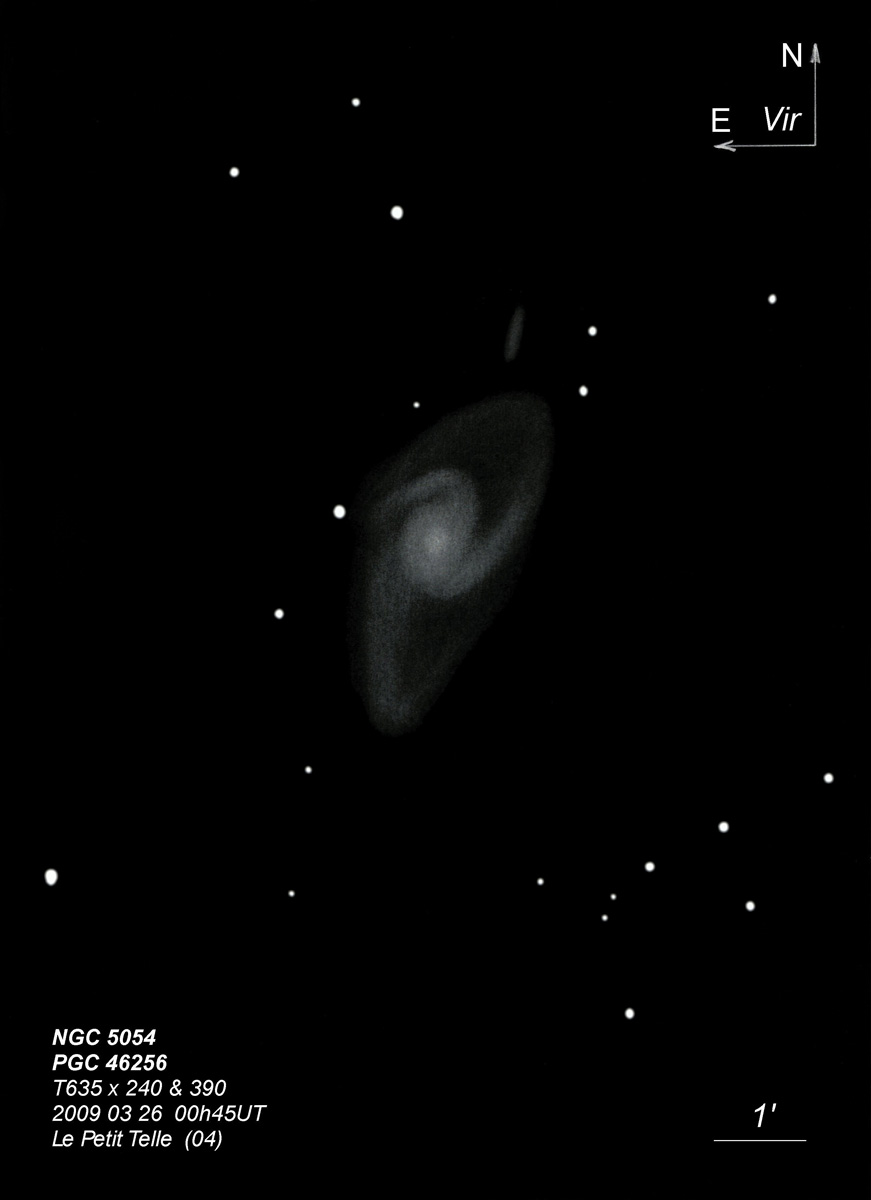
NGC 5054
Sketch and Details by Bertrand Laville
Hello,
Here is the contribution I propose this time. It is a galaxy presently well visible, and with a lot of structure. Interesting because never sketched, according my web searches.
My log is the following one: Observation of NGC 5054
Object information
Object name: NGC 5054
Object type: Galaxy
Magnitude: 10.90
RA: 13h 17m 30s
Dec: 16° 41′ 13″ S
Constellation: VIR
Observation details
Date of observation: 26 mars 2009 00:45 UT
Length of observation: 63 min
Object position: Alt: 29.4°, Az: 181.8°
Weather conditions: 11h: J++ V2-3NW t6.8° T1.5 01h25: N+/- V2N t6° hu49% QZ21.57 LZ 21.55
Observation conditions: SQMZ 21.57 SQM-LZ 21.55, naked eye limited magnitude in UMi~6.0, ~6.5at zenith. T2 P1.5 S4 (on scales 1/best to 5/worst)
Observing site: Puimoisson le PetitTelle (southern fench Alps, alt 700m)
Instrument: TN 635 Dobson Obsession
Main eyepiece: Televue Ethos 8mm
Barlow: (None)
Magnification: 390x
Notes: x102 Nagler 31mm
I am a bit disappointed: the galaxy is weak, little elongated, a/b ~ 2, pale blue, in a clear field.
x390 Ethos 8mm
It is the good power. The north-west spire is identified, then the north-east one, but the winding pattern is difficult.
PGC 46256 is easy, but only as a cigar without structure.
PGC 83913 is not visible.
More details on www.deepsky-drawings.com
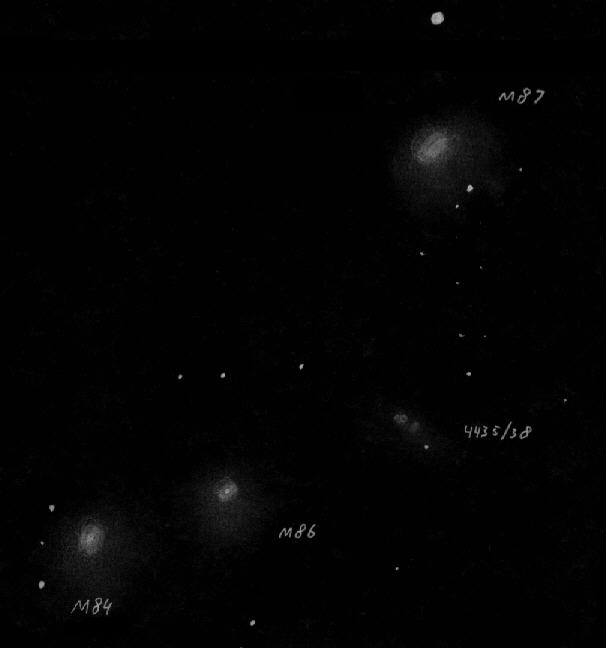
Markarian’s Chain
Sketch and Details by Michael Geldorp
Object Type: Cluster of galaxies
Instrument: 8″ Dobsonian at 49X
Date May 10, 2001
This sketch of the chain of galaxies that runs from M87 to M84 was made with an 8″ Dobsonian at 49X and shows M84, M86, M87, NGC 4435 and NGC 4438 while at higher magnifications NGC 4387 and NGC 4388 were also seen near M84. This is a wonderful area of the sky with medium sized telescopes.
The sketch was made with pencil on white printer paper. It was then scanned into the computer and inverted to give the realistic white-on-black look.
for more information and other sketches please visit http://mordorp.zymichost.com/Astrohomepage/htmlfiles/index2.html
Michael Geldorp
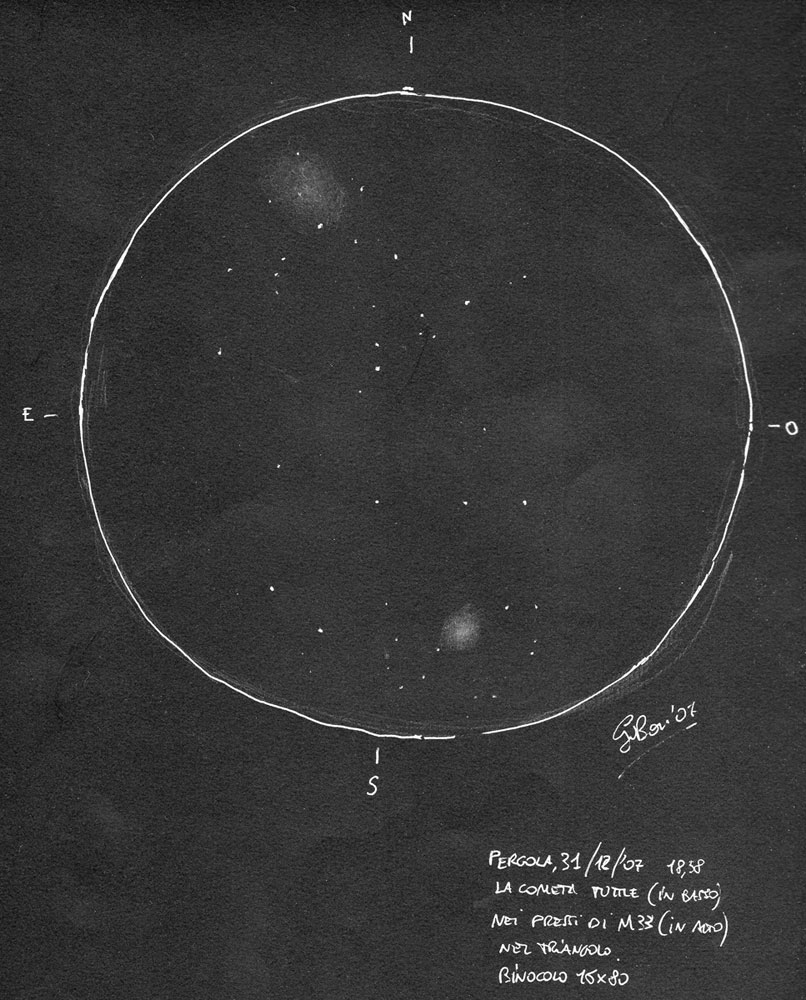
Comet Tuttle and Messier 33
Sketch and Details by Giorgio Bonacorsi
Hi,astronomy lovers,how are you? I’m fine now, i sent you the last sketches of Tuttle, realized behind my house with binocular 16×80. I have realized this in three time: first the comet and stars around Tuttle, second the stars in the central of view, third M33 and the stars around them.
The temperature are very icy,but the sky are fantastic!
Good year and clear sky.
Ciao, Giorgio.
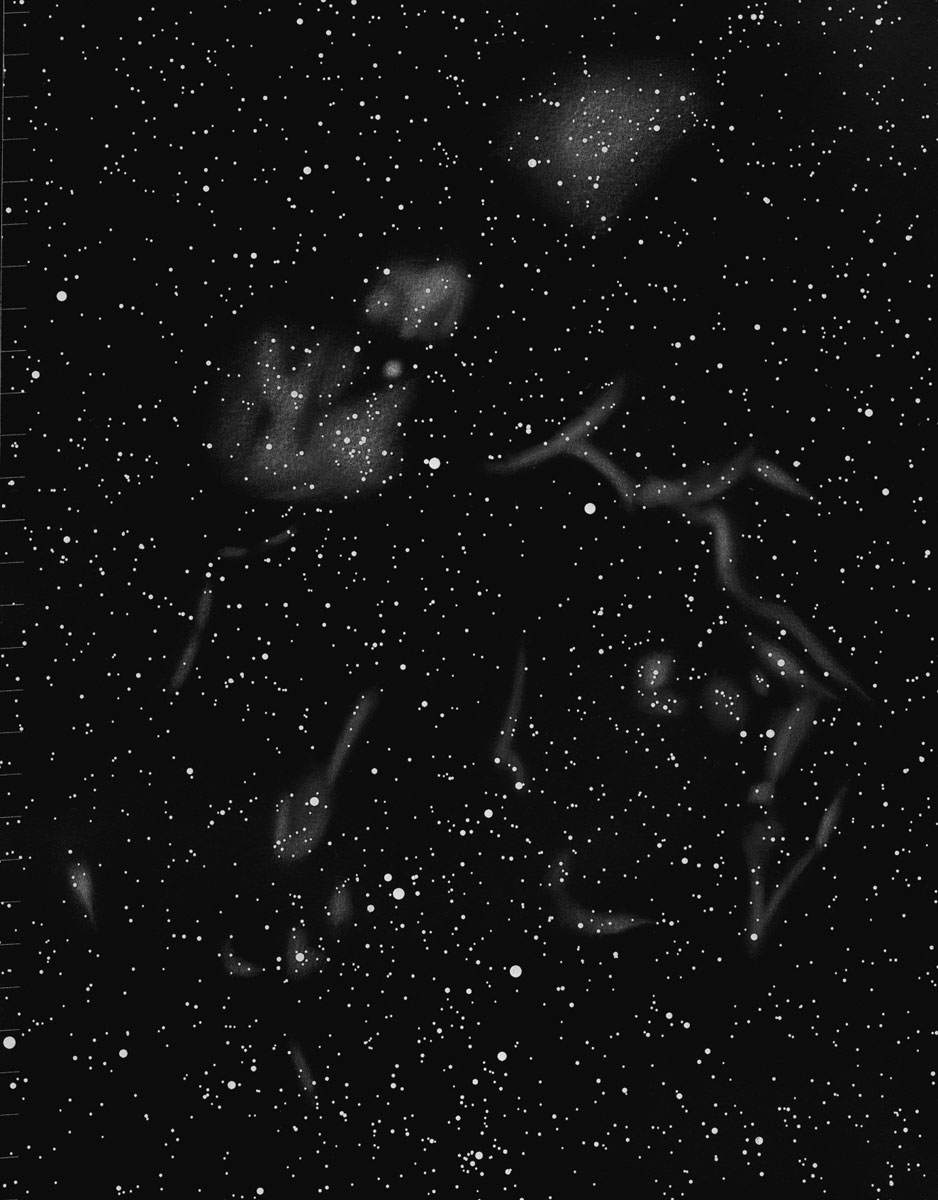
Vela Supernova Remnant
Sketch and Details by Gábor Sánta
Dear ASOD,
I want to post my newest drawing about a very interesting deepsky object.
Nearby Supernova Remnant
Object: Vela Supernova Remnant
Constellation: Vela
Date: 06. 04. 2010.
Time: 18:20-19:15 UTC
Location: 27 m above sea level next to Kalo Nero, SE Crete, Greece, EU
Instrument: 130/650 (5″ f/5) Newtonian, 32 mm Plossl (20x magn.)
Filter: O III
Limiting magnitude: better than 6.5
Printed background used
Composite (multiple-field) observation
From 2 to 10 April we three – all Hungarian amateur astronomers – were at Crete to enjoy near-south deepsky wonders in Puppis, Vela, Centaurus and Scorpius because these constellations or southern parts of them are never seen from our home. Observed Omega Cen, Cen A, NGC 2451, NGC 2477, NGC 6231 and more in the very clear sky. Light pollution was minimal.
Cause of its 800 light year distance, the Vela SNR is the nearest known and observable remnant of an exploding star (connecting to Vela Pulsar). Cause of its location in northern Vela, culminate at 10-12 deg. above the sea level (our fantastic southern horizon). So I tried to hunt its mystic filaments spread in an 8 deg diameter circle. And finally I was sucesful, I could see – by the help of a detailed map – most of dim filaments of this really interesting supernova remnant. North to this, you can see Gum 14 and Gum 17, between them the cloudy Collinder 197. These HII regions were brighter than the remnant. To save time, I used a background printed before.
I would like to suggest observing Vela SNR if you can see it at least 10-15 deg. above your horizon, southern the 35th parallel.
Best regards,
Gabor Santa
Szeged, Hungary
Leader of Deep-Sky Section in the Hungarian Astronomical Association
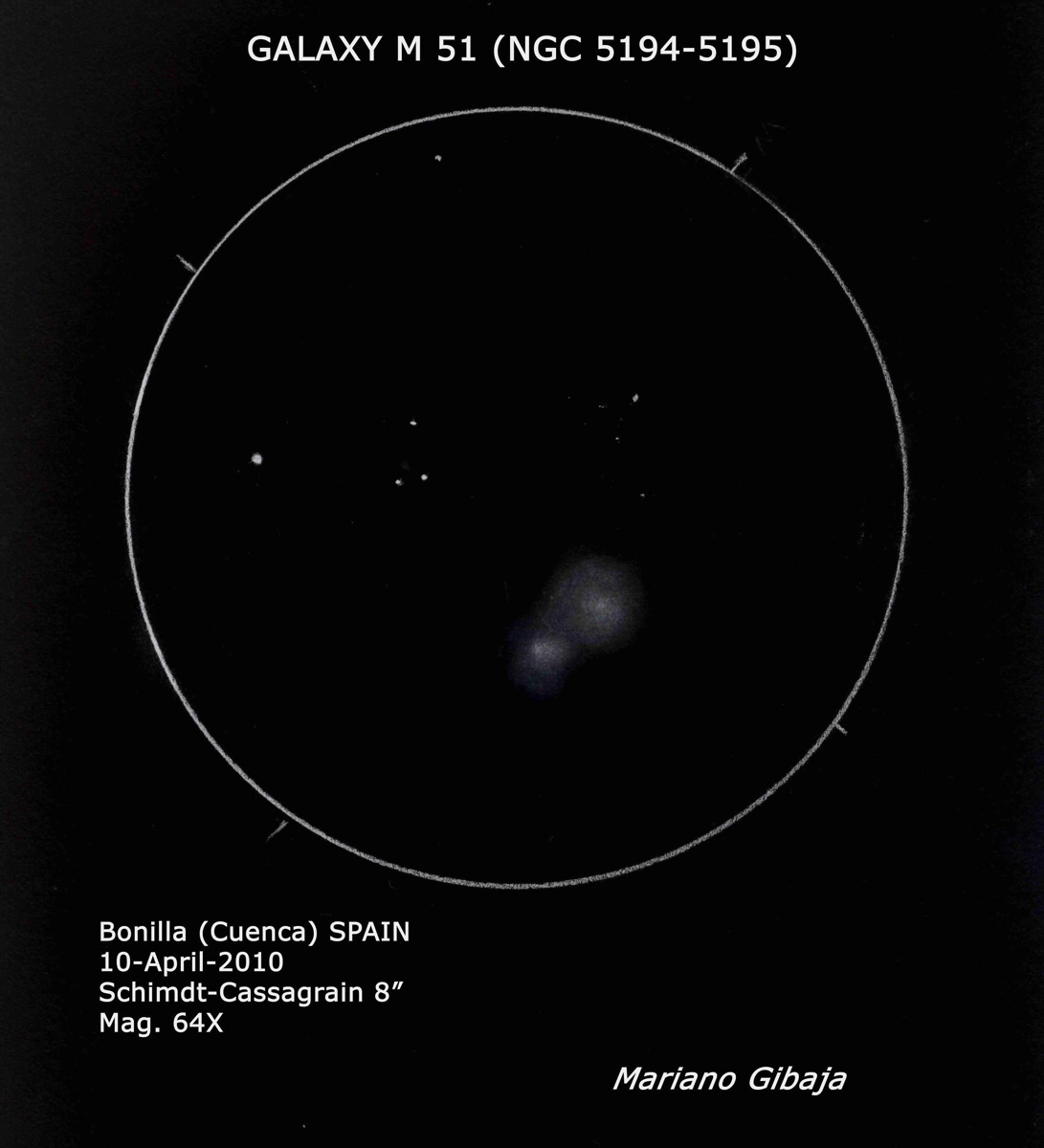
Messier 51 (NGC 5194, 5195)
Sketch and Details by Mariano Gibaja
Object Name: M 51 (NGC 5194-5195)Whirlpool in Canes Venatici constellation.
Object Type: (Galaxy type Sc)
Location: Bonilla (Cuenca) SPAIN
Date: April 10, 2010; UT: 21;30
Medium used: Graphite pencil, white paper. Photoshop:inverted
Equipment used: SCT 8″ (Mag.64X)
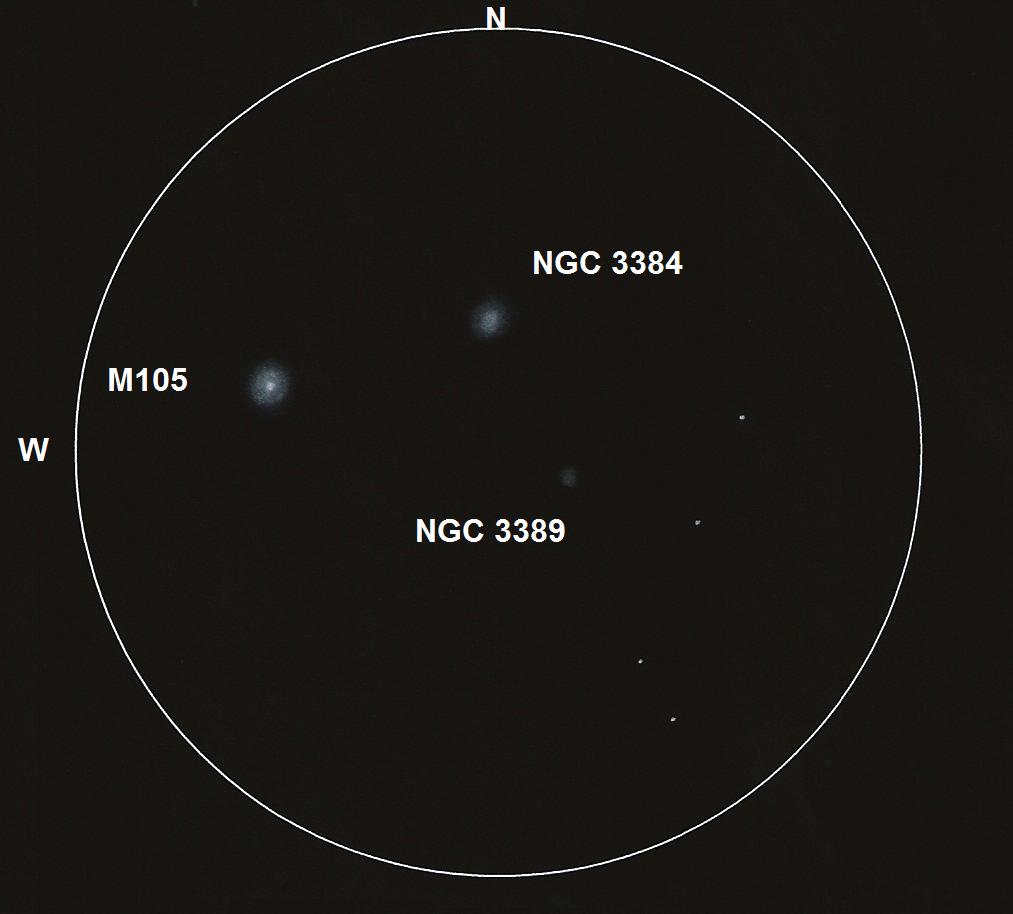
Messier 105, NGC 3384 and NGC 3389
Sketch and Details by Jef De Wit
At the eyepiece M105 is only a little bit brighter than nearby NGC 3384. You can ask why Charles Messier didn’t see both galaxies. A look at history gives us an answer to this question.
M105 was not discovered by Messier but by his contemporary Pierre Mechain in 1781. But this discovery remained hidden until 1947 when Canadian astronomer Helen Sawyer Hogg found a notation to it in Messier’s printed catalog. Meanwhile William Herschel rediscovered the galaxy and first published his position. At Hogg’s suggestion the object was included in the Messier list.
NGC 3389, at 12th magnitude, is the little brother of the trio. Some observers at Cloudy Nights Sketching Forum suggest that seeing this galaxy with a 8 cm refractor is a really hard thing to do. So I’m believing now that I observed a little “ghost” in the night sky.
Information: Steve O’Meara’s Herschel 400 & Messier Objects
Clear skies
Jef De Wit
Object Name: M105, NGC 3384 (and NGC 3389)
Object Type: galaxies
Location: Biggekerke, Netherlands (51°29’ north lat. 3°30’ east long.)
Date and time: 5 April 2010 around 21.00 UT
Equipment: William Optics Zenithstar 80 FD
Eyepiece: 7mm Nagler T6 (magnification 79x)
FOV sketch: approx 30’
NELM: 5,5 mag
Medium: graphite pencil HB/n°2 and 8B, blending stump and cotton swab, printing paper, scanned and inverted, some cleaning up was made with Paint